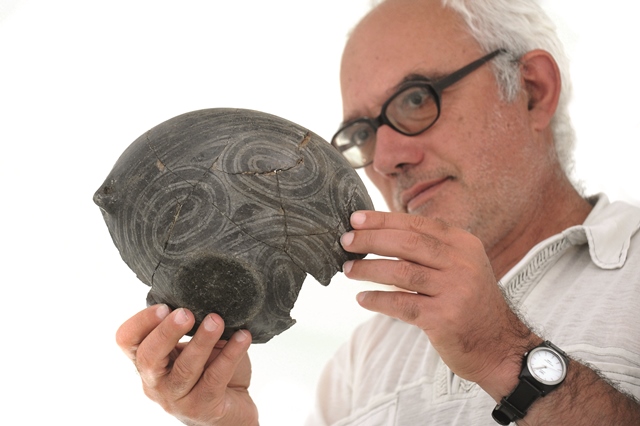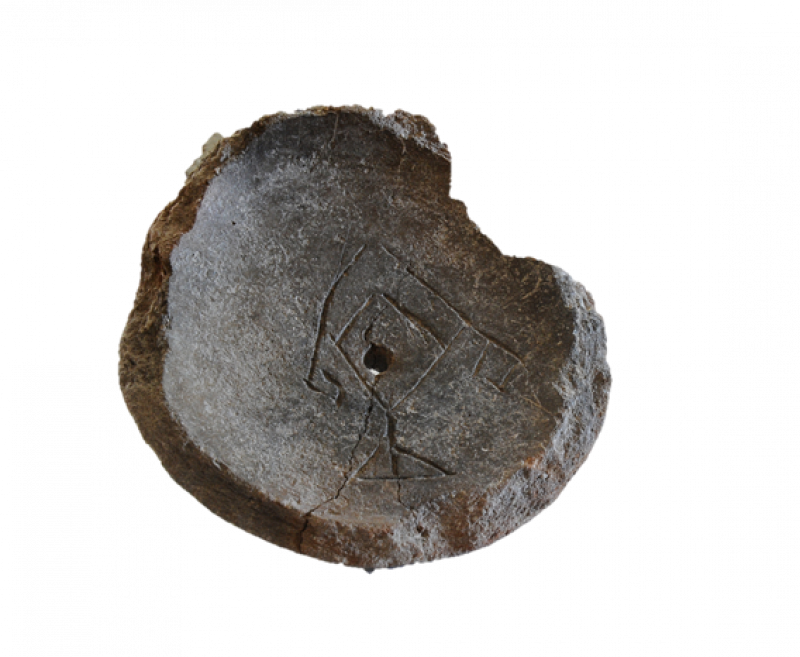The talking pot
The European town planning claimed to have emerged 6500 years ago near the Village Yunatsite
Every time when he was lifting the pot and drank it to the bottom, he was seeing that symbol. Apparently, it was saying something important, because even after he broke the pot, he didn't throw out
the signed bottom, but he saved it. What is this symbol – a warning, a spell, magic? We don't know. The pot spoke to those who could understand it. We have obviously forgotten its language.
At the big town hill near the village of Yunacite, in the area of the city of Pazardzhik, around 10 marked pots have been found. Doc. Dr Yavor Boyadzhiev – an archeologist of NAIM at the Bulgarian Academy of Sciences, who has been studying the area for ages, is frustrated. "There should be some very well-founded reason for the sign to be set at such a hidden place – on the inner side of the bottom of the dish, where it's not to be seen. It's not possible to delight the eye from there, so it wasn't for decoration. Such a symbol has not been found on other objects, so it's not an ornament either.
And it's scratched very carelessly. Apparently, it wasn't important for it to be attractive, but just to be present. The whole composition at the bottom of the object is almost identical to the symbol at the back side of the infamous tile from Gradeshnitsa, which has been considered as one of the most certain monuments, proving the presence of proto writing around our land. It is from this period.
THE FIRST "WRITINGS"
Not a few symbols, similar to the one on the pot, have been found on clay objects also at other points of our country. They are from the same period – the fifth millennium B.C. It's
almost certain that the people from that era have come to the idea, that information can be exchanged with the help of symbols. Today, we find the symbols only on lasting materials, such as clay, but in those times they could be written mainly on leather and wood, which decay underground and therefore we cannot find them.
It's completely possible for this earliest writing to have been carried by other materials, but accidentally put on clay objects. Hence, the symbols could be way more popular, than it seems today", says Yavor Boyadzhiev.
At the hill near Yunatsite he finds the marked pots at an area of only a few square meters. Their pieces are spread around the not so big open space, among the remains of multiple glaze-kilns, obviously built for years at that place, because their traces are one over the other. The finds date back to 4700-4600 B.C.
Yavor Boyadzhiev assumes that he could have come across a craft region, because besides the pieces of pots, he also finds fight axes, awls, stone axes and clawhammers,
bracelets of Mediterranean spondylus. At this same place another strange find is found from underground - a precisely made ceramic sphere with lines, similar to parallels going across it, therefore humorously called "the globe".
But at a closer look, you can notice that it is not a model of the Earth, but two coiling one over the other, but in opposite directions, snakes, whose heads meet at the "poles". (The same snake spiral, engraved on a small stone ball, has been found in Scotland, but has been dated with more than 1500 later- in 3000 BC. How has this artifact gotten there- was it a materialization of some very important idea, which people have been passing over time and space for millenniums?)

THE CITADEL
The hill near Yunatsite hides many more mysteries. But not a little is the information gathered on this place either. It's been populated since at least 5000 B.C. At that time there was a big village, running across at least 100 decares and with a few thousand inhabitants. Around 4700 B.C., its central part, situated at natural height, was surrounded by a massive clay wall – 5 meters thick and at least 4 meters tall. And on its outside, the defense was strengthened by more than 6m wide and 2m deep moat. "Such scales are rear even for later eras such as the Antiquity and Middle Ages. That's how the earliest citadel in the European history has differentiated", says Yavor Boyadzhiev.
A building boom in the surrounded by it, territory, took place for half a millennium - tens of buildings had been built, some of them were massive and even with 2 floors, reconstructed and maintained for decades. On the inner side of the defense wall, archeologists found a strange empty space, which has been left not built up on purpose for hundreds of years. Around it were built buildings, which over time have piled up over each other, while the empty space was "sinking" more and more ending in the differentiated slump, which was 5 meters deep and around 6m in diameter.
It was possible for this empty place to have been the water supply of the village- the terrain has a natural a smooth gradient to it. If the citadel is surrounded, the reserve of water is vital, but there were surroundings, which is made clear by the story of the archeologist.
Read the full article to descover the "hanging house", the harbour of the middle Trakia and the prehistoric fridge! Only in issue 2/2013 of Magazine Ossem!
At the big town hill near the village of Yunacite, in the area of the city of Pazardzhik, around 10 marked pots have been found. Doc. Dr Yavor Boyadzhiev – an archeologist of NAIM at the Bulgarian Academy of Sciences, who has been studying the area for ages, is frustrated. "There should be some very well-founded reason for the sign to be set at such a hidden place – on the inner side of the bottom of the dish, where it's not to be seen. It's not possible to delight the eye from there, so it wasn't for decoration. Such a symbol has not been found on other objects, so it's not an ornament either.
And it's scratched very carelessly. Apparently, it wasn't important for it to be attractive, but just to be present. The whole composition at the bottom of the object is almost identical to the symbol at the back side of the infamous tile from Gradeshnitsa, which has been considered as one of the most certain monuments, proving the presence of proto writing around our land. It is from this period.
THE FIRST "WRITINGS"
Not a few symbols, similar to the one on the pot, have been found on clay objects also at other points of our country. They are from the same period – the fifth millennium B.C. It's
almost certain that the people from that era have come to the idea, that information can be exchanged with the help of symbols. Today, we find the symbols only on lasting materials, such as clay, but in those times they could be written mainly on leather and wood, which decay underground and therefore we cannot find them.
It's completely possible for this earliest writing to have been carried by other materials, but accidentally put on clay objects. Hence, the symbols could be way more popular, than it seems today", says Yavor Boyadzhiev.
At the hill near Yunatsite he finds the marked pots at an area of only a few square meters. Their pieces are spread around the not so big open space, among the remains of multiple glaze-kilns, obviously built for years at that place, because their traces are one over the other. The finds date back to 4700-4600 B.C.
Yavor Boyadzhiev assumes that he could have come across a craft region, because besides the pieces of pots, he also finds fight axes, awls, stone axes and clawhammers,
bracelets of Mediterranean spondylus. At this same place another strange find is found from underground - a precisely made ceramic sphere with lines, similar to parallels going across it, therefore humorously called "the globe".
But at a closer look, you can notice that it is not a model of the Earth, but two coiling one over the other, but in opposite directions, snakes, whose heads meet at the "poles". (The same snake spiral, engraved on a small stone ball, has been found in Scotland, but has been dated with more than 1500 later- in 3000 BC. How has this artifact gotten there- was it a materialization of some very important idea, which people have been passing over time and space for millenniums?)

THE CITADEL
The hill near Yunatsite hides many more mysteries. But not a little is the information gathered on this place either. It's been populated since at least 5000 B.C. At that time there was a big village, running across at least 100 decares and with a few thousand inhabitants. Around 4700 B.C., its central part, situated at natural height, was surrounded by a massive clay wall – 5 meters thick and at least 4 meters tall. And on its outside, the defense was strengthened by more than 6m wide and 2m deep moat. "Such scales are rear even for later eras such as the Antiquity and Middle Ages. That's how the earliest citadel in the European history has differentiated", says Yavor Boyadzhiev.
A building boom in the surrounded by it, territory, took place for half a millennium - tens of buildings had been built, some of them were massive and even with 2 floors, reconstructed and maintained for decades. On the inner side of the defense wall, archeologists found a strange empty space, which has been left not built up on purpose for hundreds of years. Around it were built buildings, which over time have piled up over each other, while the empty space was "sinking" more and more ending in the differentiated slump, which was 5 meters deep and around 6m in diameter.
It was possible for this empty place to have been the water supply of the village- the terrain has a natural a smooth gradient to it. If the citadel is surrounded, the reserve of water is vital, but there were surroundings, which is made clear by the story of the archeologist.
Read the full article to descover the "hanging house", the harbour of the middle Trakia and the prehistoric fridge! Only in issue 2/2013 of Magazine Ossem!



